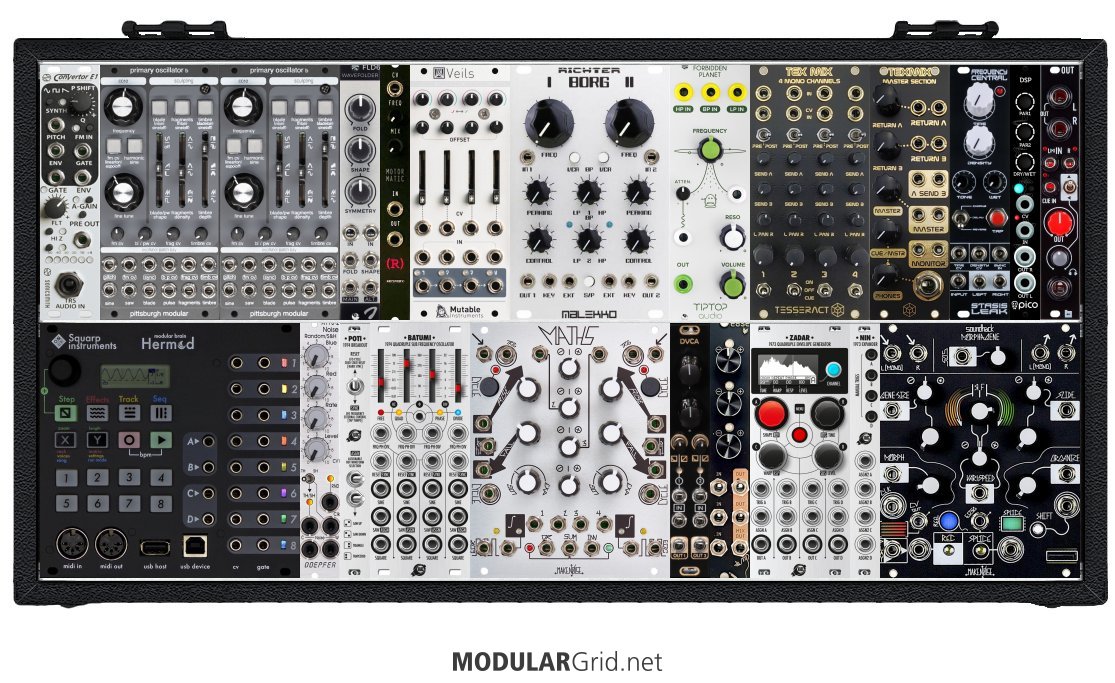Well, it's got some problems...for one thing, I can't sort out any organizational plan here, and that'll come back on you in hampering your ability to navigate the patchpanel...ESPECIALLY while learning the rig. And some choices are just bad...the "Bat", for example. OK, so it's an LPG...but it's only ONE LPG, and it costs $250? Nah, screw that...you could spend $75 more and get a Malekko redux of a rare Wiard module, the Dual Borg...which offers DUAL state-variable VCFs that can tandem with internal vactrols to allow this to also function as a state-variable gate...which is way better than one LPG that's really only lowpass. Or adding the Voltage Block...but neither of the Varigates, despite those being memory and global control for the Voltage Block. One other point...a rather disingenuous one on Pitt's part...is the hyping of "variable decay" on that LPG. Pretty dubious, really...because the majority of LPGs rely on envelope generators for that "variable decay", as well as the attack, sustain level and release time, all just as variable.
Also, and this has come up way too much as of late (someone must be doing yet another ill-advised YouTube video on this), trying to build a drum machine into a "one size fits all" modular is a terrible idea. For one thing, it's not possible to match the prices of drum machines to adding a section like that to a Eurorack build. The latter is VERY expensive. Second, anything you can send out as a trigger can, in the majority of situations, function as a drum machine's clock. And worst of all, the space that drum modules steal could probably be better used for actual SYNTH things, such as expanded modulation, an extra VCO or VCAs, etc etc.
Also...those oddly-drab-looking Pitt modules are...just...why is their multimode VCF $250? Just an overdrive...which you can do several other ways anyway? Hell, if you want a state-variable that's got tons of character, get a Tiptop Forbidden Planet, which is a clone of the Steiner-Parker Synthacon VCF...which I know first-hand as a nicely-gritty filter that RULES on lead lines. Oh...and it's less than half of that Pitt SVVCF's cost. There's a pile of that in here, actually; you could probably drop the cost of the build by 1/3rd by choosing more economical modules which can do the same job...or more!
Hmmm...let's have a go at this...[LONG PAUSE]
There we go. There's a lot of alterations here, partly to consolidate several larger modules down to one that's smaller and easier to use (especially live).
TOP (voice row): The Sonicsmith input/p-2-v is up first, then a pair of the Pitt VCOs. After that is a Joranalogue FOLD6, which handles waveshaping, etc duties. Then the little thing next to that is Recovery's Motormatic...a bit-crushing ring mod! Want metallic clangers that've got GRIT? That's why it's there. Veils is next to sum the oscillators, etc, and since Veils has a "breakable" mixbus, you can use it as a pair of 2 -> 1 mixers, or mix down VCAs 2, 3, and 4 while keeping VCA 1 isolated. Then, so that you can have a proper (well, two, actually) filter AND LPG, I dropped in the Malekko reissue of the Dual Borg. Basically, it's two independent state-variable filters which also have their own VCAs, meaning you can either use the filters in series or parallel in the three usual modes, OR you can get them to be state-variable GATES...which gets pretty fun for percussives. Then I put in the Steiner-Parker yowl and shriek leadline VCF, in this case in the guise of a Tiptop Forbidden Planet. The Synthacon VCF, as I recall it in my actual Synthacon from some years ago, was capable of virtually ripping a hole in the mix to get RIGHT...OUT...FRONT. Best lead voice filter EVR! Anyway, after the Forbidden Planet, there's your performance mixer, a Tex-Mix set of four mono ins and the master section. The Tex-Mix channels all have VCAs to control levels, plus dual AUX sends and panning, and a few more surprises...and the master section gives you TWO FX send/return busses, mono out and stereo in. Effects come next...a Frequency Central Stasis Leak and an Erica Pico DSP to handle your mono-to-stereo bus architecture, then the Befaco OUT follows these.
BOTTOM: You'll notice that I ripped out the Pam's...because the Hermod handles what it does, plus eight sequencer channels, MIDI interfacing via DIN or USB, four CV inputs, and on and on. This, basically, is a "performance sequencer"...it has a lot of capabilities that you'll really have to work at to go through them all. And this does mean that, yes, it has a learning curve...but so does a lot of this, so nothing unusual there. Anyway, after that is the noise/s&h, then the Batumi with its Poti expander, giving you four LFOs with some extra tricks via the Poti. Maths is next because...Maths. Then an After Later dual VCA, based on the Veils topology, and a Tenderfoot triple attenuverter/mixer provide some basic modulation manipulation. Xaoc's Zadar and Nin then provide four channels of envelopes, and at the end is the Morphagene in a better, more performable location.
This took a bit of time, which was mainly spent on brainstorming module shrinking and function combining. But to do a proper build, those are important. You can even use "big modules" well if you know your little support module stuff, and also if you know how to both consolidate functions into one module, or how to group modules to work together in a more ergonomic fashion. As it is, this actually has MORE functionality than the previous iteration while, at the same time, has much more of an intuitive layout (voicing top, left to right, and control on bottom to allow "patching upwards" for employing modulation) and strikes me as something that 99% of synthesists could sit down and blow their minds with after 5-10 minutes of patching and twiddling.


